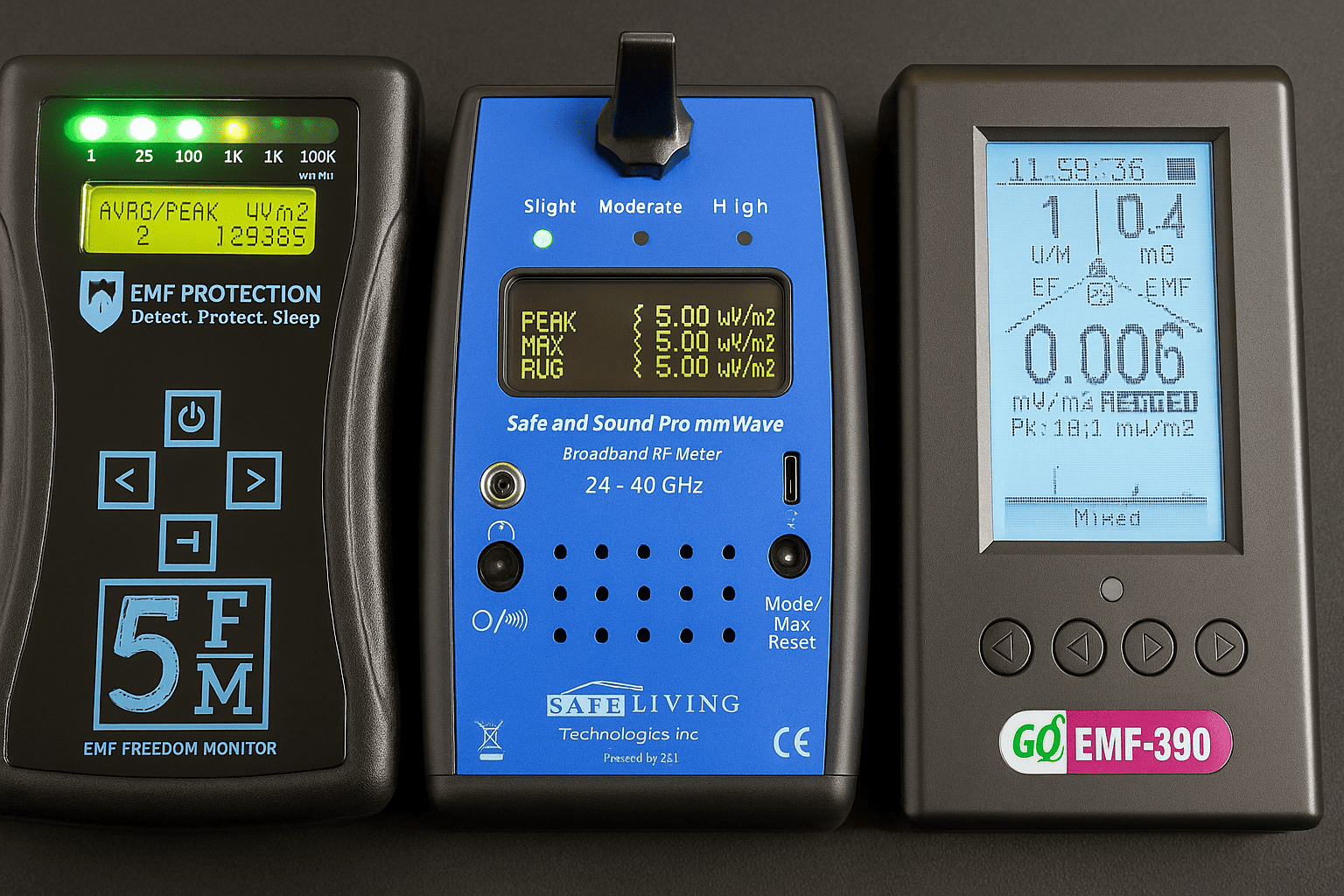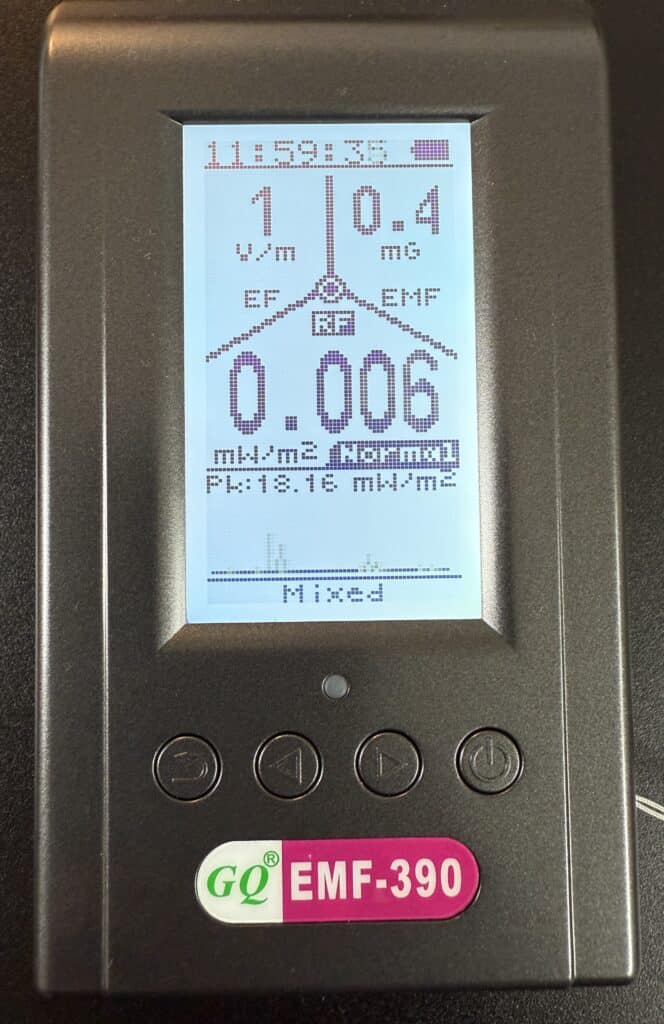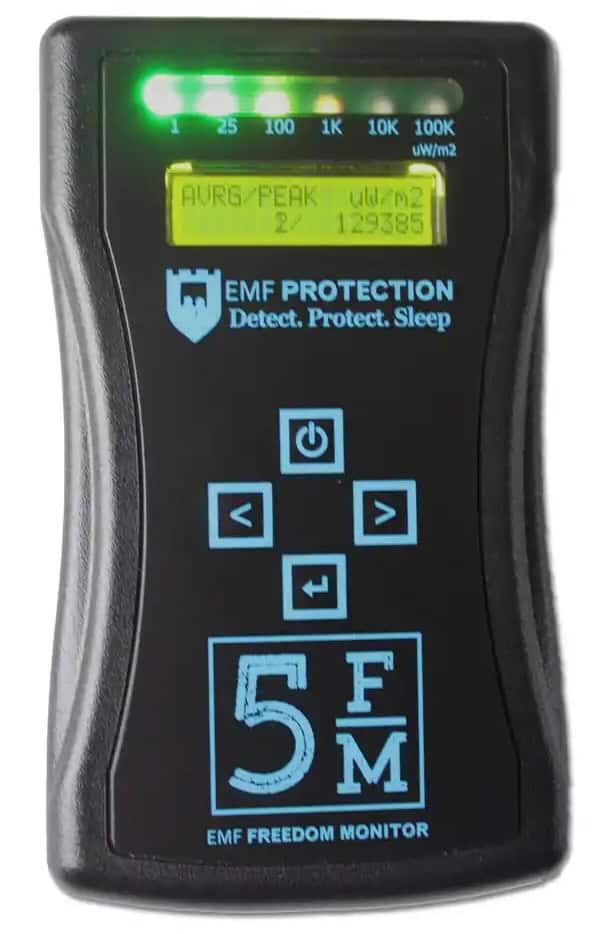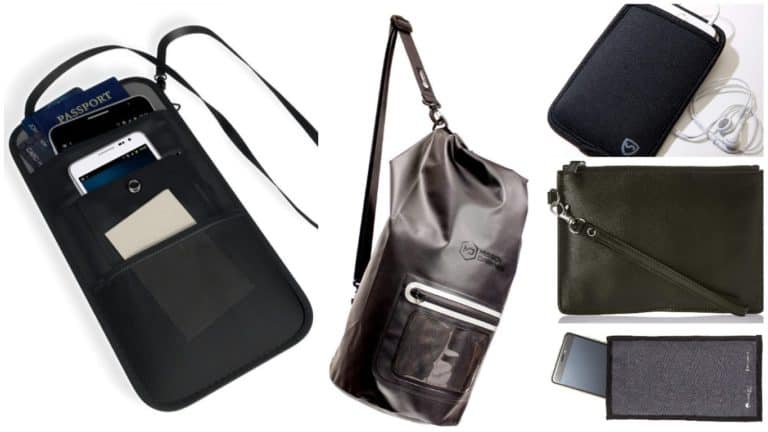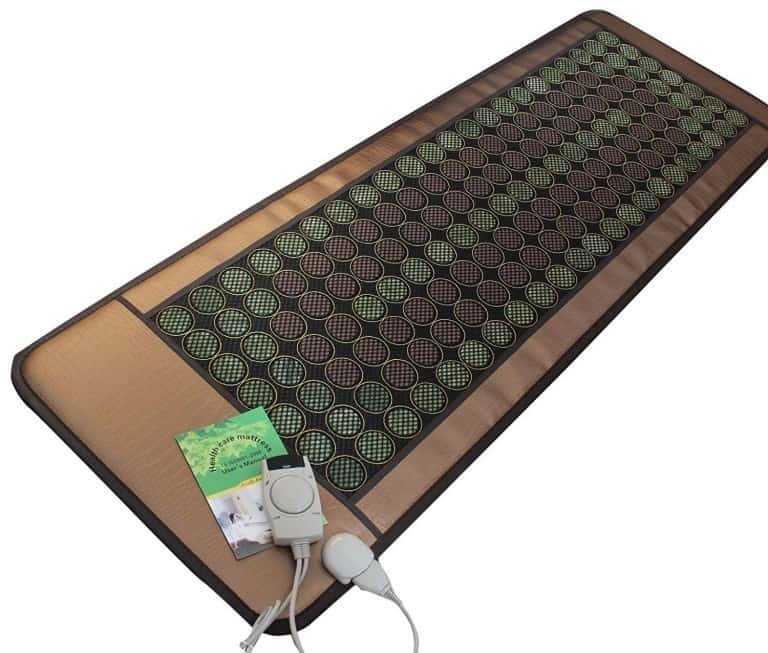The 3 Best 5G EMF Radiation Meters – 2025 (Including mmWave)
*The information on EMF Academy is for educational purposes only and is not a substitute for professional medical advice. Please review our full Medical Disclaimer for more details. This post may contain affiliate links. Please see my disclosure to learn more.
If you've spent any time reading the other article on EMF Academy, you probably know that I talk all the time about the importance of understanding EMF radiation. Once you begin to understand it, you'll realize just how important it is to have a good quality EMF meter.
But here's the thing: 5G has recently really changed things.
Don't get me wrong, a quality EMF meter like the ones I recommend in my complete guide is still extremely valuable, and the best tool you'll have for understanding your exposure risks.
However, most EMF meters are not designed to detect the full range of 5G frequencies, especially the newer high-band frequencies known as “millimeter waves”, which operate between 20 and 40 GHz.
So, if you're serious about wanting to detect how much EMF radiation is being emitted from the 5G towers in your area, you're going to need a special kind of 5G EMF meter.
So, in this article, I'll walk you through what makes a 5G EMF meter different, why it matters, and the three absolute best options available right now in 2025.
Let's get started!
What Makes a 5G EMF Meter Different?
When 5G first started rolling out, there was a ton of confusion about what it actually was and how we might be able to measure it.
Part of the problem is that 5G isn't just a single frequency, or even a single technology. It's a whole spectrum of frequencies that includes low-band, mid-band, and high-band (the millimeter waves we talked about earlier) signals.
Most EMF meters that you'll find on the market right now (including some of my favorites like the Trifield TF2) are great at detecting RF (radio frequency) radiation from sources like WiFi, Bluetooth, or older cellular networks.
However, they usually top out at reading frequencies around 6 to 8 GHz.
So, here is where we have a problem: 5G millimeter waves operate between 20 GHz and 40 GHz, well beyond what most meters can detect.
So, what makes a 5G EMF meter different?
1. Higher Frequency Detection
First, and most importantly, is the ability to detect very high-frequency sources of radiation, especially in the millimeter wave (mmWave) band.
These are typically the frequencies that are being used in most cities and urban areas for 5G, especially places like city centers, sports stadiums, and other busy places.
In order to measure these, your meter needs to have a specialized antenna that can accurately detect these high-frequency signals, and the right kind of meter to measure them correctly.
2. Specialized Antenna
Most RF meters use internal or standard stub antennas to measure radiation up to around 8 GHz.
However, 5G-capable meters, like the ones we'll talk about shortly, often use stub antennas calibrated for 20-40 GHz.
In some cases, these meters will also use, or offer, directional horn antennas that can help pinpoint exactly where the radiation is coming from.
This is especially important because mmWave 5G signals don't travel very far compared to lower frequency signals, and are highly directional.
If you have an EMF or RF meter that can't detect these waves, you might think you're environment has far less EMF radiation exposure than it really does.
3. Attenuator Options
Millimeter wave signals can actually be really strong, especially at short range.
In order to deal with this, some high-end 5G meters offer optional attenuators, which reduce the signal strength going into the meter and prevent the meter from being overwhelmed.
This is one of the ways that professional-grade 5G meters can still be really accurate across a very broad range of environments, because they have attachable attenuators and antennas to adapt the signal detection to their needs.
To Summarize:
If you're using a standard EMF or RF meter that stops around 6-8 GHz, you're likely missing out on a big part of the 5G spectrum.
That's why this guide is going to focus specifically on the available meters that were built, or at least optimized, to detect the full range of 5G signals.
The Best 5G EMF Radiation Meters of 2025
Like we talked about above, when it comes to detecting 5G radiation, especially the high-band frequencies, not just any EMF meter will do.
Since 5G is newer technology, the demand for meters that can detect it is still far lower than it is for standard EMF meters, which means we have fewer options available to us.
However, there are still a few great consumer-grade 5G meter options that work really well, and that's what I'll be covering in this section.
| Product | mmWave Detection | RF Range | Directional Antenna | Best For |
|---|---|---|---|---|
| Safe and Sound Pro mmWave | ✅ Yes | 18–40 GHz | Optional horn | High-accuracy mmWave detection |
| GQ EMF-390 | ❌ No | Up to 10 GHz | No | Affordable, general use |
| FM5 Path Complete | ✅ Yes | 1–32 GHz | Yes | Full 5G range + future upgrades |
1. Safe and Sound Pro mmWave Meter
Check the current price on Amazon.
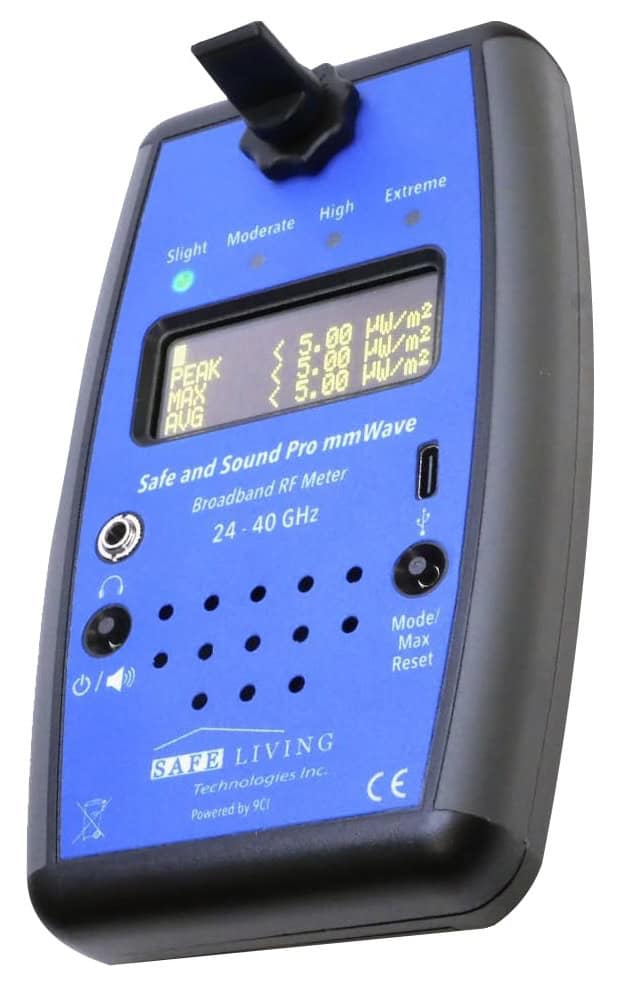
In my opinion, the Safe and Sound Pro mmWave from Safe Living Technologies is the best meter for measuring true high-band 5G radiation (20-40 GHz).
This is the first consumer-level device in North America (don't worry, you can get it overseas as well) that accurately measures the frequency bands where millimeter wave 5G operates.
Until very recently, this really wasn't even possible unless you wanted to spend thousands and thousands of dollars on lab-grade equipment, accessories, and calibration.
What Makes It Unique
- True mmWave Detection: Don't be fooled, some RF meters will say they detect 5G, but they can't actually detect frequencies in these ultra-high ranges. However, the mmWave Pro actually can detect these true 5G millimeter waves.
- Optional Horn Antenna: If you want better directional detection (locating exactly which way a source of radiation is coming from), the optional horn antenna you can get with this meter can offer that.
- Extremely Sensitive: If you get the optional attenuator (I'd suggest you do), this meter can detect signals as low as 5 µW/m² and as high as 50,000,000 µW/m²
- Professionally Calibrated: Most standard EMF and RF meters are not sensitive or powerful enough to need calibration; however, this one does. Luckily, the meters come already professionally calibrated to meet ISO 9001:2015 and ISO/IEC 17025 standards.
How It Works
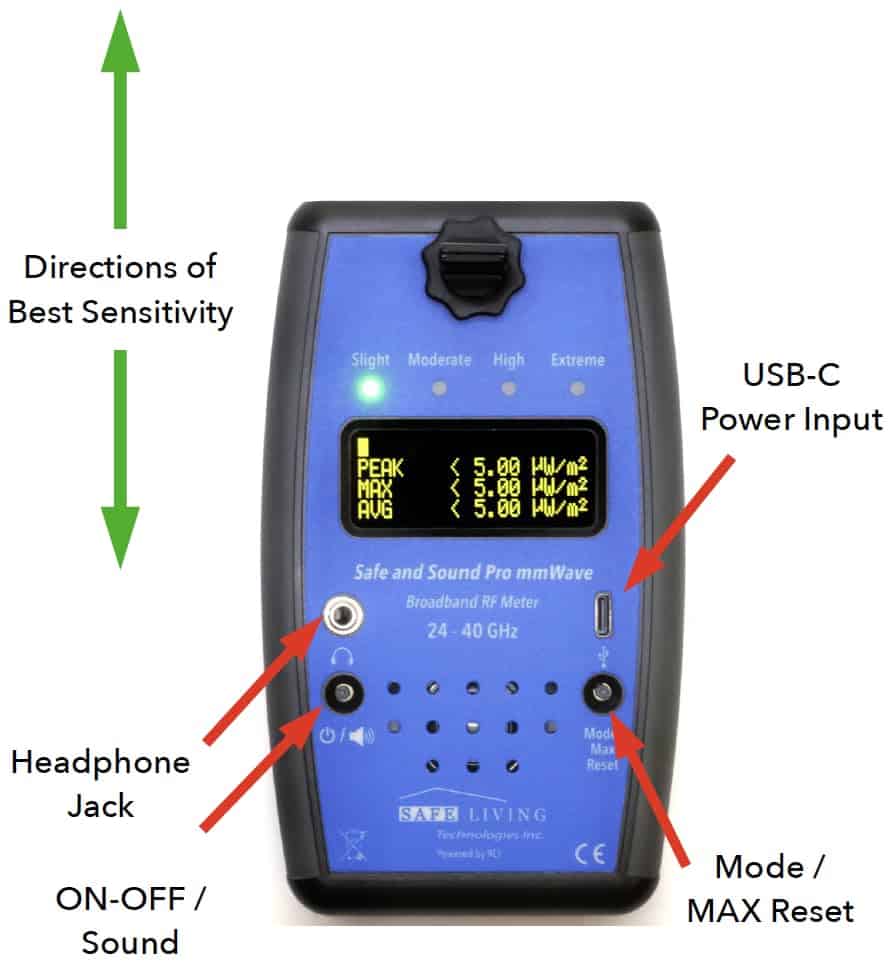
As soon as you turn on the device, it first performs a quick self-calibration and displays a battery indicator.
You can switch between antennas (if you have any optional ones) by selecting the appropriate mode on the display.
When using the standard stub antenna that comes with it, be sure the SLT logo is facing forward for optimal detection.
As you move through an environment, the meter gives you a peak (PEAK), average (AVG), and MAX readings.
It will also display an LED indicator on the front panel to help you understand the potential danger of the detected frequencies:
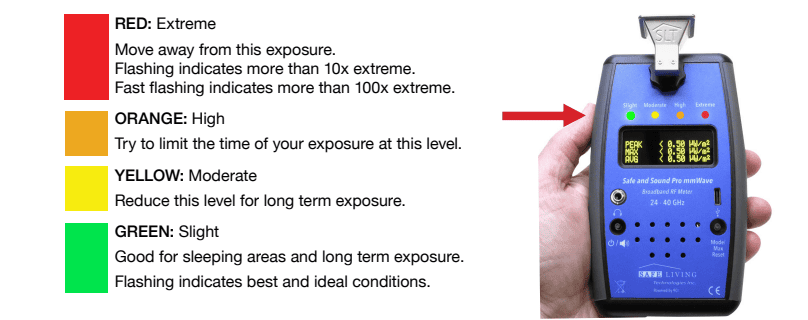
In addition to the LED light, there is also a built-in speaker that will give you real-time audio feedback about the detected frequencies.
I don't want to bog you down too much into the details of how this works, but if you want to read more, you can check out the user manual or the listing on Amazon.
What It doesn't Do
Just so we're clear:
This meter does not measure electric fields (EF) or magnetic fields (MF). So, if you're used to meters like the Trifield TF2, which measure all three types of EMF radiation, then it's good to know that the mmWave Pro ONLY measures RF radiation.
It also does not detect lower-frequency RF radiation, like WiFi, Bluetooth, or sub-6 GHz 5G. So, for your general EMF radiation detection needs, a quality standard meter (like the Trifield TF2) will actually do more for you.
Final Thoughts
This meter isn't for your casual EMF detection, and the price does reflect that.
However, I really believe that this is far and away the best consumer-grade 5G radiation meter on the market right now.
If you want to learn a ton more about how the Safe and Sound Pro mmWave works, here is a great video from the company:
2. GQ EMF-390 Multi-Field EMF Meter
Check the current price on Amazon.
If you're wanting to get a really well-rounded and affordable EMF meter that can still detect 5G (just not the ultra-high frequency mmWave bands), then the GQ EMF-390 is probably exactly what you need.
Although I love the Trifield TF2 and many other EMF meters, the EMF-390 is probably the most feature-rich meter you can get for the price.
While it can't measure high-band millimeter wave 5G like we've been talking about (frequencies above 20 GHz), the EMF-390 does still detect the low and mid-band 5G signals, which would include things like some 5G towers, phones, and many smart devices.
What I Like About It
- Covers all three types of EMF radiation: The GQ-390 allows you to detect radio frequency, electric fields, and magnetic fields with its 3-axis sensor.
- RF Detection up to 10 GHz: This is enough range to detect low- and mid-band 5G signals.
- Real-time spectrum analyzer and pulse graph: This is really helpful for visualizing when and how the devices around you are transmitting and can give you further insight into the radiation sources in your environment.
- RF source identification: Although from my personal experience, I can tell you that this can sometimes be misleading, the GQ-390 will tell you what type of source it is detecting radiation from, such as a router, smart meter, or cell tower.
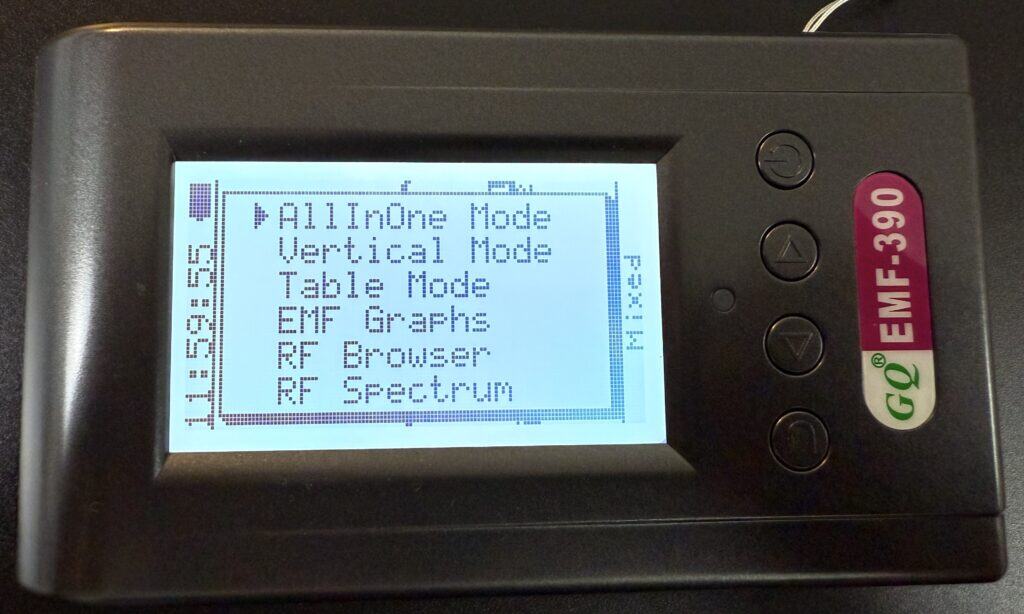
What It Doesn't Do
- Doesn't detect mmWave 5G (20-40 GHz): This is the most important thing to know. It does still detect the low and mid-band 5G signals, but you'll need a different meter for the high bands.
- Limited RF spectrum graph: This is not super important for everyone, but one thing to note is that although it will detect frequencies up to 10 GHz, the visual graphs only show up to 2.5 GHz
- Not the most user-friendly: I love all the features of this EMF meter, but because it has so many features, display modes, and options, some people can find it to be a bit difficult to navigate.
Final Thoughts
If you're wanting an EMF meter that can do it all, and detect some 5G frequencies, then this is the one I would probably recommend, especially for the price.
I've been using this meter for a few years now alongside a few others, and it has held up really well and continues to be accurate and responsive after heavy use.
While it won't detect the mmWaves that the Safe and Sound Pro will, it will give you a ton of information about the EMF radiation that is around you, and it is still a good option for a 5G radiation meter as well.
3. FM5 Path 5G Monitor
View or purchase the product here
This, along with the Pro mmWave from Safe and Sound, are really the only “consumer-grade” 5G radiation meters on the market right now.
If you're looking for a highly sensitive 5G radiation meter that includes millimeter wave detection, then this is another strong contender.
One nice thing about this meter over the Safe and Sound is that it does still detect traditional RF sources (1 MHz to 10 GHz) while still being able to detect mmWave 5G (24-32 GHz).
However, you need to know what you're getting, because there are two versions of this meter:
- FM5 Path Basic: This less expensive version includes the 1 MHz to 10 GHz modules (this will cover things like WiFi, Bluetooth, and sub-6 GHz 5G).
- FM5 Path Complete: This version includes the mmWave antenna module out of the box, which will also allow you to detect the higher frequency 5G signals (24-32 GHz).
What I Like About It
- Covers mmWave 5G: Like we've talked about, this is one of the few actual 5G radiation meters on the market that can measure all bands of 5G currently being used.
- Modular and upgradeable: Since it has a slot for an additional antenna, you will be able to upgrade and adapt it in the future to continue to measure 5G radiation as new frequencies are used.
- Fast Response Time: This meter has a really fast response time, taking thousands of measurements each second to offer really high accuracy.
Areas For Improvement
- Fairly Expensive: This technology is so new, and the options are quite limited, so it's understandable that these meters would be more expensive than other EMF meters. However, this meter is a bit more expensive than the Safe and Sound Pro mmWave.
- Shorter Battery Life: The battery life of the mmWave version (FM5 Path Complete) draws a ton of power, and only has a moderate battery life.
Final Thoughts
The FM5 Path Complete is potentially the most flexible EMF meter on this list, since it sort of combines some of the abilities of the first two options, allowing it to detect all bands of 5G frequencies.
I like that they thought to include an additional antenna slot for future upgrades, and overall, I think this is a solid and smart product. However, I wouldn't personally recommend it over the Safe and Sound Pro mmWave.
Related Questions
Now that we've talked about what I think the best consumer 5G radiation meters are in 2025, I want to go over some of the questions I get most often around this topic.
Can All EMF Meters Detect 5G?
No. Most EMF meters, like many of the options in my article on the Best EMF Meters, can only detect some 5G frequencies (usually the low- and mid-bands). Many EMF meters, in fact, can't detect radio frequency (RF) radiation at all.
Very few EMF meters are capable of measuring the high-band 5G frequencies, often called millimeter waves, ranging in the 20-40 GHz range.
If you want a meter that can detect these millimeter waves, then I would recommend either the Safe and Sound Pro mmWave or the FM5 Path Complete that I talked about above.
Why is mmWave 5G Harder To Measure?
Millimeter wave signals use extremely high frequencies, which is a fairly new technology. These mmWaves don't travel as far or penetrate buildings as well as lower-band signals.
For these reasons and others, most meters didn't include this ability because there wasn't really a need.
Now that mmWave technology is being used in many cities, we're finally getting access to relatively affordable consumer meters that can detect this 5G radiation.
Is It Worth Getting a 5G Radiation Meter If I don't Live In a Big City?
Honestly, probably not (yet).
At least at the time I'm writing this article, in the latter half of 2025, mmWave 5G is mostly limited to urban areas, especially places with really high population density where super-fast data speeds are needed (think sports stadiums, airports, dense areas of large cities).
If you live in a more rural area, then it's likely that the “5G” signal you see on your phone is coming from low or mid-band 5G, which many traditional RF meters can still detect.
What's The Difference Between Low, Mid, and High-Band 5G?
Here's a quick breakdown:
- Low-band 5G (600–1000 MHz): Long-range, slower speeds; often repurposed 4G spectrum.
- Mid-band 5G (1–7 GHz): Good speed and range; most common in suburban areas.
- High-band 5G (mmWave) (20–40+ GHz): Extremely fast, short-range; mostly used in dense urban environments like downtown areas of cities, stadiums, etc.
Conclusion
If you really want to understand your exposure to 5G radiation, especially the mmWave technologies, then having the right kind of meter is essential.
Most EMF meters simply aren't designed to measure the ultra-high frequencies used by millimeter wave 5G, and the meters that can are hard to find.
That is why I put this list together: to show you that there are now some good consumer-grade options for detecting this type of EMF radiation.
As always, I'll do my best to keep this article constantly updated as new options hit the market. If you feel I've missed any, please drop a comment below or contact me.

